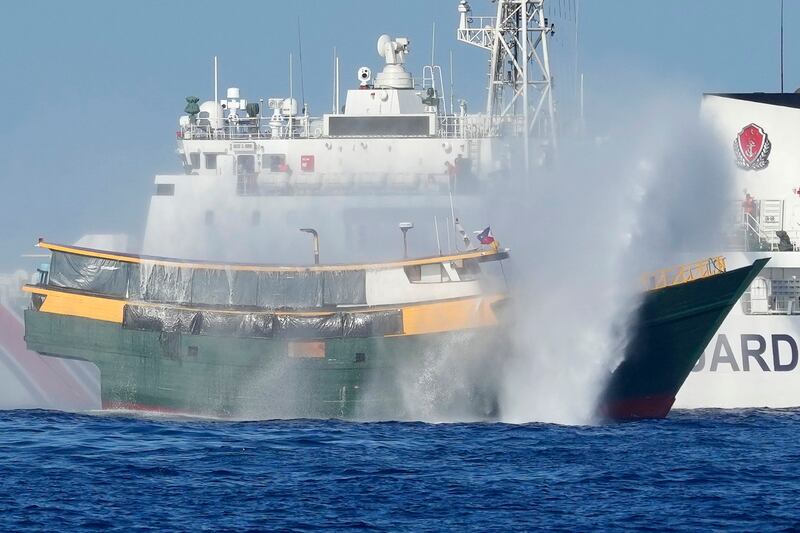Large-scale military drills between the United States and the Philippines began on Monday, with a portion of this year’s “Balikatan” exercise expected to take place for the first time in Manila’s exclusive economic zone in the South China Sea – a move that could anger Beijing.
At least 16,000 troops – 11,000 from the U.S. and 5,000 from the Philippine side – are taking part in the drills, along with hundreds of troops from Australia and France, who were invited to be direct participants in the 2024 Balikatan (shoulder-to-shoulder) Exercise.
This year's iteration will incorporate new aspects, with part of the exercise taking place outside the Philippines'12 nautical-mile territorial waters and in the EEZ, where tensions have risen lately between Manila and Beijing over their contending claims in the South China Sea.
This year, the Philippine Coast Guard has also been invited to participate, the first time in 39 years that a civilian entity has been asked to join the drills.
Drills on deterring a ground invasion will take place in Batanes, the northernmost Philippine island chain that lies just across the strait from Taiwan, officials said, but they declined to give other details about that portion of the drills closed to press coverage.
“This exercise represents the essence of unity, collective responsibility and enduring partnership between the Republic of the Philippines and the United States of America and other partners,” Filipino military chief Gen. Romeo Brawner said as he declared the three-week drills open.
“It is not a partnership of convenience but rather a clear reflection of our shared history, unwavering commitment to democracy and respect for international law in our pursuit of peace and security in the Indo-Pacific region,” he said.
Brawner emphasized that both nations are coastal states that “understand the importance of maritime cooperation in addressing the complex challenges that threaten peace and security in our region.”
This was an obvious reference to China, which has of late allegedly ramped up its harassment of Filipino boats delivering supplies to an old navy ship that Manila purposely grounded on Second Thomas Shoal (Ayungin Shoal) to serve as its outpost in the area.
Last month, three crew members of a Philippine supply boat were injured when the China Coast Guard fired water cannons to block its advance.
The Philippines and the United States are mutual defense treaty partners, and Washington has said repeatedly that it will come to Manila’s aid in case of an armed attack on any of its military and civilian ships.

Lt. Gen. Willian Jurney, the commander of the U.S. Marine Corps in the Pacific, who is in charge of the American side, said this year’s drills were more expansive.
“If you are not getting better, you are getting worse. Each year, we work closely with our partners to make Balikatan more challenging,” he said. “We’re building military readiness across the full range of combined and joint operations. When we get better, the Philippines gets stronger, safer and more secure.”
This time around, the Balikatan drills will also welcome observers from other Southeast Asian neighbors, Britain, Canada, South Korea, India, Japan, New Zealand and Germany, Brawner said.
Philippine move pays off
Ray Powell, a maritime security analyst at the Gordian Knot Center for National Security Innovation at Stanford University, said China’s “bullying” in the South China Sea had pushed the Philippines closer into the embrace of its defense ally, the United States.
“China’s escalations – intended to cow Manila into submission – have instead served to galvanize the Philippines’ friends and allies by reminding them of the near and present danger [that] its expansionist agenda presents to the international order,” he told BenarNews.
Powell also noted that President Ferdinand Marcos Jr. appeared to have come away from a trilateral summit with his U.S. and Japan counterparts in Washington earlier this month with some victories – foremost among them, the securing of economic and defense backing by the two allies.
China has protested the drills, saying that its position on the South China Sea remained clear and that it blamed Manila for allegedly provoking hostilities by infringing on its territory.
This year, the Americans have dedicated ships, aircraft including their F-22 Raptor fighter jets, and medium-range capability weapons system, among others, for the exercise.
The Philippine military will be showcasing some of the military hardware it acquired for its modernization program, including a frigate, FA-50 fighter jets, and Super Tucano light attack aircraft.
One of the major events under this year’s Balikatan is a joint sail among ships from the Philippines, U.S. and France in the South China Sea, from April 25 to May 4. These vessels will be conducting gunnery drills and other training activities during the joint sail.
Another major event is a maritime strike or ship sinking exercise which will be held off Ilocos Norte province in the northern Philippines on May 8.
Jeoffrey Maitem, Mark Navales and Jojo Riñoza contributed to this report by BenarNews, an RFA-affiliated online news organization.
